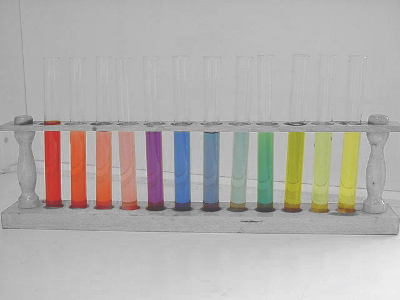Anthocyanin
Red Cabbage pH Indicator
Anthocyanin is a pigment found in nature and it has interesting properties. Red cabbage is a vegetable that contains this pigment. When the cabbage is boiled or blended it releases the water- soluble pigment. This pigment has a purple colour to it when it is dissolved in water (around the pH of 7) and it will act as a pH indicator. Although when it is mixed with a strong base it turns blue and with a strong acid it turns red. There are also different shades of colours in between the two extremes so it acts a little like universal indicator solution and shows you roughly what pH a substance has.
Our Top Gift Ideas for Young Scientists
 |
  |
 |
|---|
To make your red cabbage pH indicator solution you will need:
- 10 big red cabbage leaves
- 1.5 litters of water
- Blender
- Knife
- Sieve

Method:
Pour the water into the blender then roughly chop the red cabbage leaves so that they fit. Blend the mixture until the water becomes a violet/ purple colour whic is the colour of anthocyanin at a pH of 7. Now get a bottle or container in which you will store the solution. Use a sieve to filter out the red cabbage as you pour the indicator into your container.
Note: if you want to increase the quantities then just add more water or red cabbage. If you want a stronger and more intense colour for your indicator increase the amount of red cabbage you add. You could try boiling the cabbage instead of blending it this should release more of the pigment (this option will make the house/ lab smell of cabbage).
Now that you have your indicator solution you can test different things in your kitchen to see if they are acidic or basic. For example you could test:
'Science Kids'
Stay updated and subscribe to "Science News For Kids" our monthly e-zine.
- Lemon juice
- Orange juice
- A salt solution
- Baking soda
- Vinegar
- A sugar solution
- Soapy water
- Coffee
- Antacid tablets
Chemistry magic
You can use your anthocyanin indicator to perform some scientific magic to amaze and astound your friends and family. Start by filling three glasses with the indicator, then take another 3 and fill one with clear vinegar (a.k.a. acetic acid) One with water and one with a solution of sodium hydrogen carbonate (baking soda). All three glasses will appear to be filled with water but they will turn the indicating solution different colours (except for the water which won’t change the indicating solutions colour).
Science fair experiment
Which antacid table is the best at increasing pH?
Antacids are taken by some to reduce the pain of heartburn. It does this by increasing the pH of the stomach environment (making it less acidic). To test which one is the best at increasing the pH you will need to use an acidic solution made up of an acid (e.g. vinegar) and a red cabbage ph indicator. You will need around 4 or 5 different antacid brands. Then do some test runs to determine on how much vinegar, antacid and indicating solution to use to get the best results in terms of colour change. I recommend using enough anthocyanin indicator to give an intense colour to the solution. Once you have determined how much to use of vinegar and antacid you can start your experiment. When doing the experiment also make sure to keep the amount of vinegar, antacid and red cabbage indicator the same as these are the control variables. The solution of red cabbage indicator and vinegar will be a bright pink-red to start with and as it then becomes more basic it will transition into darker and darker reds until it becomes purple. Once purple which is neutral it will become darker and darker purple until it becomes dark blue and eventually green. Before you start the experiment make sure you know how the colours of the indicating solution correspond with the pH. You will not need to know the pH of each solution just which solution is more alkaline.